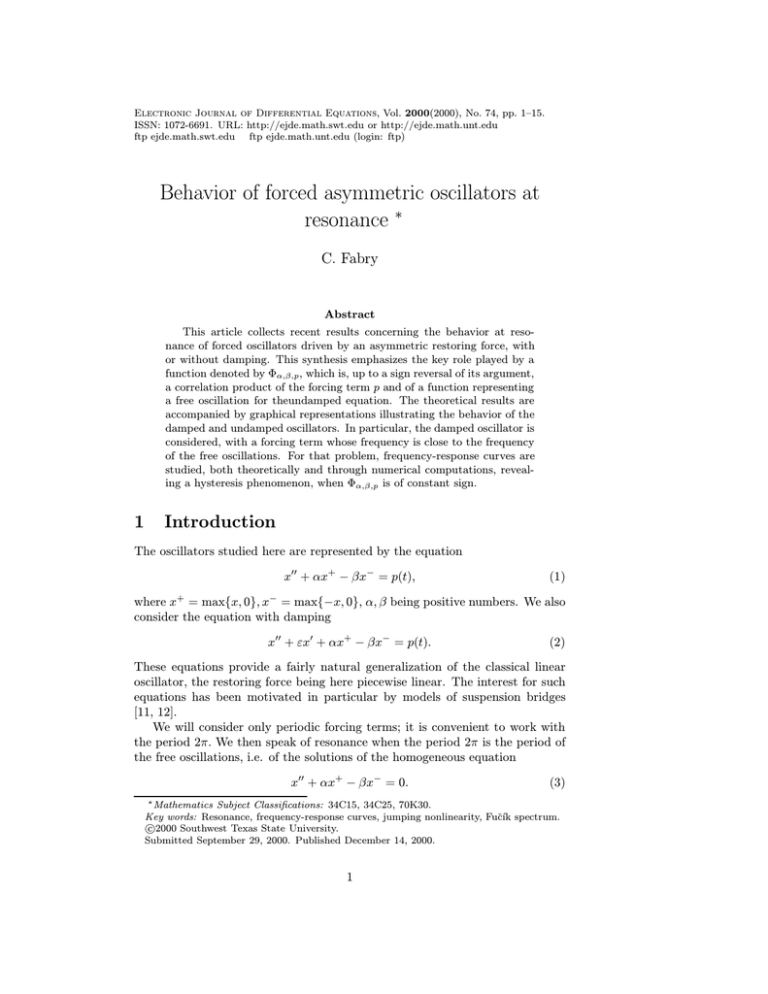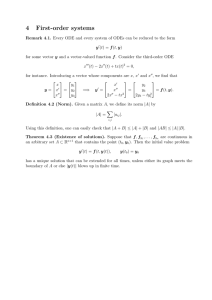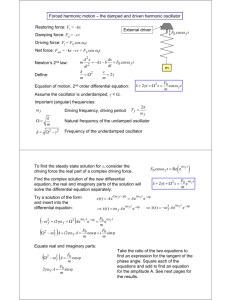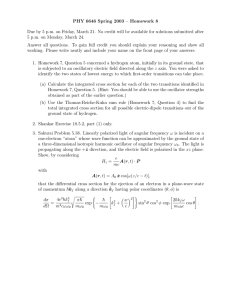Document 10747473
advertisement

Electronic Journal of Differential Equations, Vol. 2000(2000), No. 74, pp. 1–15.
ISSN: 1072-6691. URL: http://ejde.math.swt.edu or http://ejde.math.unt.edu
ftp ejde.math.swt.edu ftp ejde.math.unt.edu (login: ftp)
Behavior of forced asymmetric oscillators at
resonance ∗
C. Fabry
Abstract
This article collects recent results concerning the behavior at resonance of forced oscillators driven by an asymmetric restoring force, with
or without damping. This synthesis emphasizes the key role played by a
function denoted by Φα,β,p , which is, up to a sign reversal of its argument,
a correlation product of the forcing term p and of a function representing
a free oscillation for theundamped equation. The theoretical results are
accompanied by graphical representations illustrating the behavior of the
damped and undamped oscillators. In particular, the damped oscillator is
considered, with a forcing term whose frequency is close to the frequency
of the free oscillations. For that problem, frequency-response curves are
studied, both theoretically and through numerical computations, revealing a hysteresis phenomenon, when Φα,β,p is of constant sign.
1
Introduction
The oscillators studied here are represented by the equation
x00 + αx+ − βx− = p(t),
(1)
where x+ = max{x, 0}, x− = max{−x, 0}, α, β being positive numbers. We also
consider the equation with damping
x00 + εx0 + αx+ − βx− = p(t).
(2)
These equations provide a fairly natural generalization of the classical linear
oscillator, the restoring force being here piecewise linear. The interest for such
equations has been motivated in particular by models of suspension bridges
[11, 12].
We will consider only periodic forcing terms; it is convenient to work with
the period 2π. We then speak of resonance when the period 2π is the period of
the free oscillations, i.e. of the solutions of the homogeneous equation
x00 + αx+ − βx− = 0.
(3)
∗ Mathematics Subject Classifications: 34C15, 34C25, 70K30.
Key words: Resonance, frequency-response curves, jumping nonlinearity, Fučı́k spectrum.
c
2000
Southwest Texas State University.
Submitted September 29, 2000. Published December 14, 2000.
1
2
Behavior of forced asymmetric oscillators at resonance
EJDE–2000/74
It is easy to see that this occurs when
1
2
1
√ +√ = ,
α
n
β
(4)
for some integer n. The curve defined by (4), which passes through the point
(n2 , n2 ), is one of the so-called Fučı́k curves [9, 10] for this boundary value
problem; we will denote it by Cn . When (α, β) ∈ Cn , all solutions of (3) are
2π-periodic; we will denote by ϕα,β the particular solution corresponding to the
initial conditions x(0) = 0, x0 (0) = 1; it is easily computed that
√ 1
π
for t ∈ 0, √ ,
√ sin α t
α
α (5)
ϕα,β (t) =
p
1
π
π 2π
for t ∈ √ ,
,
β t− √ )
− √ sin
α
α n
β
ϕα,β being of minimal period 2π/n.
Despite the simplicity of equations (1), (2), the behavior of the solutions
turns out to be more complicated that could be expected at first sight. As will
appear from the results recalled below, the global picture depends crucially on
the fact that the function Φα,β,p , defined by
Z 2π
1
p(t)ϕα,β (t + θ) dt (θ ∈ R),
(6)
Φα,β,p (θ) :=
2π 0
vanishes or not at some point; that function has been introduced by Dancer
[2, 3]. Notice that, if (α, β) ∈ Cn , the function Φα,β,p , as ϕα,β , is of period
2π/n; its number of zeros in the interval [0, 2π/n) will be determining for the
behavior of the oscillator.
The paper is organized as follows. Section 2 is a short presentation of formulas concerning the function Φα,β,p , that will be needed later. In Section 3, we
present results concerning the equation without damping (1), whereas Section
4 is devoted to the equation with damping (2). In Section 5, we also discuss
the equation with damping, when the forcing term is no longer of period 2π,
but of period close to 2π; we will study the variation of the amplitude of 2πperiodic solutions with respect to the frequency of the forcing term and draw
frequency-response curves.
2
The function Φα,β,p
We list here, for later reference, some results about the function Φα,β,p . Remember that we are particularly interested in the number of zeros of Φα,β,p in the
interval [0, 2π/n).
If (4) is satisfied with α = β = n, the differential equation (3) is linear and
we have ϕn,n (t) = sin(nt)/n ; the function Φn,n,p (θ) is then, up to a factor 2/n,
made of the Fourier components of order n of the function p. Hence, Φn,n,p is
of the form A cos(nt) + B sin(nt); it is identically zero when the corresponding
EJDE–2000/74
C. Fabry
3
Fourier coefficients A, B are equal to 0; otherwise, it has 2 zeros in the interval
[0, 2π/n). Clearly, the function Φn,n,p (θ) cannot be of constant sign, a situation
which, by contrast, can occur when α 6= β.
In the examples considered below for α 6= β, we will deal for instance with
right-hand sides p of the form p(t) = a + b cos(kt). For such a function p,
assuming that (α, β) satisfy (4) with n = 1 and that α 6= β, it is computed that
1
a 1
Φα,β,p (θ) =
−
π α β
b
β−α
kπ
kπ
1 + cos √
cos(kt) + sin √
sin(kt) . (7)
+
2π (k 2 − β)(k 2 − α)
α
α
The function Φα,β,p is of constant sign if
αβ
|a|
> 2
cos
|b|
|k − β||k 2 − α|
kπ
√
2 α
,
(8)
the sign being that of a(β − α). It immediately results from the expression (7)
that, when the inequality (8) is reversed, Φα,β,p has 2k simple zeros in [0, 2π).
3
Forced oscillator without damping
Concerning equation (1), with a forcing term p of period 2π, the comparison
with the linear oscillator suggests the following two questions:
• For which p does the problem have 2π-periodic solutions?
• For which p does the problem have unbounded solutions?
A fairly complete answer to those questions is provided by the results recalled
below. We start with sufficient conditions for the existence of 2π-periodic solutions.
Proposition 1 ([6]) Assume that (α, β) ∈ Cn , and that p is continuous and
2π-periodic. Then, if Φα,β,p has 2z zeros in [0, 2π/n) , all zeros being simple,
and if z 6= 1, equation (1) has (at least) one 2π-periodic solution.
Notice that, since Φα,β,p is 2π/n-periodic, the number of zeros in [0, 2π/n) ,
if they are simple, must be even. The above result contains of course the case
of a function Φα,β,p of constant sign, a case already treated by Dancer [2, 3]. It
also follows from Proposition 1 that the only situations where equation (1) can
have no 2π-periodic solution, are the case where Φα,β,p has 2 zeros in [0, 2π/n) ,
and the case where Φα,β,p has multiple zeros. For the first case, it is possible to
exhibit 2π-periodic forcing p such that equation (1) has no 2π-periodic solution
(see [2, 3, 11, 17]). In particular, Wang Zaihong [17], extending results of Lazer
and McKenna [11], has shown that, if (α, β) ∈ Cn ,
x00 + αu+ − βu− = cos nt
4
Behavior of forced asymmetric oscillators at resonance
EJDE–2000/74
has no 2π-periodic solution. We do not know if functions p exist, for which Φα,β,p
has multiple zeros and for which equation (1) has no 2π-periodic solution.
On the other hand, it can be shown that, with (α, β) ∈ Cn , the set of
2π-periodic solutions of equation (1) is bounded, unless Φα,β,p has multiple
zeros. Examples of unbounded sets of 2π-periodic solutions are however easy
to construct. For instance, if ψ is a twice differentiable function such that
ψ(t)ϕα,β (t) > 0, for all t such that ϕα,β (t) 6= 0, and if we define p by p(t) =
ψ 00 (t) + αψ + (t) − βψ − (t), it is easy to verify that, for any k > 0, ψ + kϕα,β is
a solution of (1). With that choice of p, the function Φα,β,p can be seen to be
identically zero.
It has been observed by Ortega [15] that, because of a result of Massera
[14], if equation (1) admits no 2π-periodic solutions, then all solutions must
be unbounded. That condition is of course not necessary to have unbounded
solutions. Indeed, a result of Alonso and Ortega [1] shows that, as soon as Φα,β,p
has zeros (assumed to be simple), equation (1) will admit unbounded solutions.
Proposition 2 If the function Φα,β,p takes both positive and negative values,
and if all its zeros are simple, then there exists R > 0 such that every solution
x of equation (1) with
x(t0 )2 + x0 (t0 )2 > R
for some t0 ∈ R, is such that
x(t)2 + x0 (t)2 → +∞
as t → +∞ or t → −∞.
Combining Propositions 1 and 2, it clearly appears that, when α 6= β, equation (1) can have both 2π-periodic and unbounded solutions. It is the case for
instance for the equation
x00 + αx+ − βx− = cos(3t),
with (α, β) ∈ C1 , α 6= β. Indeed, it can be shown that, with p(t) = cos(3t), we
2
have Φα,β,p (t) = Aα,β cos(3t) + Bα,β sin(3t), with A2α,β + Bα,β
6= 0, ∀(α, β) ∈
C1 , α 6= β. Both Proposition 1 and Proposition 2 thus apply to that equation.
By contrast to Proposition 2, it has been proved by Liu Bin [13] that, when
Φα,β,p is of constant sign, and provided that p is sufficiently regular, all solutions
of (1) are bounded.
Proposition 3 If p is of class C 6 , and if the function Φα,β,p is of constant
sign, then all solutions of equation (1) are such that
sup{|x(t)| + |x0 (t)|} < ∞.
t∈R
EJDE–2000/74
C. Fabry
5
In order to gain some understanding of the behavior of solutions corresponding to large initial conditions, let us use the change of variables
x(t) = ρu(t)ϕα,β (t + θ(t)), x0 (t) = ρu(t)ϕ0α,β (t + θ(t)) ;
(9)
we will assume that ρ > 0 is “large”, but fixed, and consider initial conditions
like u(0) = 1, θ(0) = θ0 . That change of variables transforms (1) into
u0
=
θ0
=
1
p(t)ϕ0α,β (t + θ)
ρ
1
p(t)ϕα,β (t + θ).
ρu
(10)
(11)
The factor 1/ρ being small, this can be considered a weakly nonlinear system to
which the method of averaging can be applied. The averaged system, for which
the variables will be denoted σ, τ, writes
σ0
=
τ0
=
1 0
Φ
(τ )
ρ α,β,p
1
Φα,β,p (τ ).
−
ρσ
(12)
(13)
If we take the initial conditions σ(0) = u(0), τ (0) = θ(0), the method of averaging (see [16]) ensures that σ(t), τ (t) are approximations of u(t), θ(t), with an
error which is of the order of 1/ρ, on an interval whose length is of the order of
ρ. But,
(14)
σ(t)Φα,β,p (τ (t)) = C
is a first integral for the system (12), (13). It then follows that, u(t)Φα,β,p (θ(t))
will be close to a constant on an interval of length of the order of ρ. The following
conclusions can be drawn from that observation.
1st case. We discuss first the case where Φα,β,p is of constant sign. Since
u(t)Φα,β,p (θ(t)) remains close to a constant C on a interval of the order of ρ,
u(t) will, on such an interval, oscillate roughly between
|C|
|C|
and
,
max |Φα,β,p |
min |Φα,β,p |
the constant C depending on the initial conditions. Since, by (9), ρu can be
interpreted as the amplitude of the solutions, this means that a beating phenomenon is observed. Moreover, since u0 is proportional to 1/ρ and since the
amplitude is of the order of ρ, the amplitude fluctuations are slower for larger
solutions. Figure 1 represents the actual behavior of a solution for the equation
x00 + αx+ − βx− = −2 + cos t,
with α = 2, and (α, β) ∈ C1 . Using formula (8) and the remark following it, it
is easily seen that, for the choice of α, β, p made here, Φα,β,p is positive.
6
Behavior of forced asymmetric oscillators at resonance
EJDE–2000/74
20
100
200
300
400
500
-20
-40
-60
Figure 1: Beating phenomenon
The proof of Proposition 3 is based on a version of the so-called “twist
theorem” of Kolmogorov-Arnold-Moser. To get an idea of the twist conditions
involved, observe that, by (12), (13), (14) we have
2π
2π
min Φ2α,β,p ≤ |τ (2π) − τ (0)| ≤
max Φ2α,β,p .
ρ|C|
ρ|C|
Denoting τ1 , τ2 solutions corresponding respectively to ρ1 , ρ2 , it is clearly possible to find ρ1 , ρ2 , with ρ2 > ρ1 , such that
|τ2 (2π) − τ2 (0)| ≤ |τ1 (2π) − τ1 (0)|,
independently of τ1 (0), τ2 (0). This is, for the averaged system (12), (13), the
desired twist effect: interpreting (ρσ, τ ) as pseudo-polar coordinates, it appears that the angular variation |τ (2π) − τ (0)|, on the interval [0, 2π], decreases when ρ is increased. From there, it can be shown, through the approximation of u, θ by σ, τ that, for ρ sufficiently large, the Poincaré map
(x(0), x0 (0)) 7→ (x(2π), x0 (2π)), relative to equation (1) for the period 2π, also
presents a twist effect for solutions of large amplitude.
The dynamics of the system can be illustrated by looking at Poincaré sections. Figure 2 shows Poincaré sections for the equation
x00 + αx+ − βx− = 2.5 + cos t,
with α = 2, and (α, β) ∈ C1 . For that choice of α, β, p, the function Φα,β,p
is negative everywhere. One recognizes in Figure 2 invariant curves for the
Poincaré map associated to equation (1), and the so-called “islands chains”
typical of area-preserving maps, when a twist condition is satisfied.
EJDE–2000/74
C. Fabry
7
4
2
2
4
6
-2
-4
Figure 2: Poincaré sections for x00 + 2x+ − βx− = 2.5 + cos t, with (2, β) ∈ C1 .
2nd case. Suppose that Φα,β,p has zeros, all zeros being simple. Assuming
C 6= 0, the relation σ(t)Φα,β,p (τ (t)) = C prevents Φα,β,p (τ (t)) from changing
sign. By (13), we see that τ 0 will be of constant sign. For the sake of definiteness,
assume for instance that τ is decreasing. If τ ∗ is the nearest zero of Φα,β,p at
the left of τ (0), it is fairly clear that we must have
lim τ (t) = τ ∗ .
t→∞
By (14), we then have
lim σ(t) = +∞.
t→∞
and, by (12),
lim σ 0 (t) =
t→∞
1 0
Φ
(τ ∗ ),
ρ α,β,p
showing that, asymptotically, the growth of σ is linear (τ ∗ is assumed to be a
simple zero of Φα,β,p ). Since σ(t) is close to u(t) on large intervals, the same
conclusions will roughly hold for the amplitude u(t). The argument can be
turned into a proof of Proposition 2 (see [8]).
8
Behavior of forced asymmetric oscillators at resonance
EJDE–2000/74
An example of solutions whose amplitude grow exactly linearly is provided
by the equation
x00 + αx+ − βx− = 2ϕ0α,β (t),
with (α, β) ∈ C1 . Indeed, it is easy to check that x(t) = (t − t0 )ϕα,β (t) is a
solution of that equation for t ≥ t0 .
4
Forced oscillator with damping
We consider now the equation with damping
x00 + εx0 + αx+ − βx− = p(t).
(15)
We will assume that the damping coefficient is small and will study the following
questions:
• For which p does equation (15) have 2π-periodic solutions whose amplitude
grows to infinity when ε goes to 0?
• In the opposite case, what is the behavior of solutions with large initial
conditions?
The following proposition [6, 7] shows basically that large amplitude 2πperiodic solutions are present when Φα,β,p has simple zeros, whereas the set of
2π-periodic solutions is bounded, independently of ε close to 0, when Φα,β,p is
of constant sign.
Proposition 4 Let α, β satisfy (4).
(i) Assume that θ∗ is a simple zero of Φα,β,p . Let u∗ := 2|Φ0α,β,p (θ∗ )|. Then,
for εΦ0α,β,p (θ∗ ) > 0, with ε small enough, the equation (15) has a 2π-periodic
solution xε such that
(xε (t), x0ε (t)) =
1
uε (t)(ϕα,β (t + θε (t)), ϕ0α,β (t + θε (t))) ,
|ε|
the functions uε , θε being 2π-periodic and such that
lim uε (t) = u∗ , lim θε (t) = θ∗ ,
ε→0
ε→0
uniformly in t. Moreover, the solution xε is asymptotically stable if ε > 0,
unstable if ε < 0.
(ii) If Φα,β,p has 2z zeros in [0, 2π/n), all simple, there exists ε0 > 0 and
R > 0 such that, if 0 < |ε| ≤ ε0 , there are exactly z 2π-periodic solutions of (15)
having k · k∞ -norm larger than R. If z = 1 and if problem (1) has no 2π-periodic
solution, problem (15) has a unique 2π-periodic solution for 0 < |ε| ≤ ε0 .
(iii) If Φα,β,p is of constant sign (and does not vanish), the set of 2π-periodic
solutions of (15) is bounded, independently of ε in some neighborhood of 0.
EJDE–2000/74
C. Fabry
9
When Φα,β,p is of constant sign, the information provided by the above
theorem, concerning the 2π-periodic solutions, can be completed by a result
concerning all solutions of (15). Indeed, as stated in the next proposition [4],
when Φα,β,p is of constant sign, all solutions end up ultimately in a set whose
size is o(ε) for ε going to 0 by positive values.
Proposition 5 Let α, β satisfy (4). If Φα,β,p of constant sign (and does not
vanish), and if xε denotes any solution of (2),
lim lim sup ε(|xε (t)| + |x0ε (t)|) = 0.
ε→0+
t→∞
In Figure 3, we show the asymptotic behavior of the Poincaré sections for
the damped oscillator represented by the equation
x00 + εx0 + αx+ − βx− = 2.5 + cos t,
with α = 2,(α, β) ∈ C1 , ε = 0.001. As indicated above, the function Φα,β,p
is then negative everywhere. An analysis of the numerical results shows the
presence of four periodic solutions, three of them being subharmonic solutions of
order 3, 4 and 7 respectively; all solutions tend towards those periodic solutions
when t → ∞. This damped oscillator thus apparently has several asymptotically
stable periodic solutions.
3
2
1
1
2
3
4
5
-1
-2
-3
Figure 3: Poincaré sections for x00 + 0.001x0 + 2x+ − βx− = 2.5 + cos t, with
(2, β) ∈ C1 .
10
5
Behavior of forced asymmetric oscillators at resonance
EJDE–2000/74
Frequency-response curves
In this section, we study the damped equation, with a forcing term whose frequency is close, but not equal to the frequency of the free oscillations, i.e. we
assume that (α, β) satisfy (4) and consider the equation
x00 + εx0 + αx+ − βx− = p(t) ,
with ε “small” and p of period T, with T = 2π + O(ε), for ε → 0. By means of
a change of time scale, it is basically equivalent to consider the problem
x00 + εx0 + (1 + εk)(αx+ − βx− ) = p(t),
(16)
where (α, β) still satisfy (4), p is of period 2π and k is a given constant. That
equation has been studied in [5]; we recall here the main results.
It is shown in [5] that, when 2π-periodic solutions having an amplitude of
the order of 1/ε are present, they can be written under the form
(xε (t), x0ε (t)) =
with
1
uε (t)(ϕ(t + θε (t)), ϕ0 (t + θε (t)),
|ε|
lim θε (t) = θ∗ , lim uε (t) = u∗ = 2|Φ0α,β,p (θ∗ )|,
ε→0
ε→0
(17)
θ∗ being a solution of
εΦ0α,β,p (θ∗ ) > 0 ,
kΦ0α,β,p (θ∗ ) − Φα,β,p (θ∗ ) = 0.
(18)
Conditions (18) are easily studied by looking, in the xy-plane, at the intersection
of the line y = x/k with the curve parametrized by
θ 7→ (Φα,β,p (θ), Φ0α,β,p (θ)).
The fact that Φα,β,p admits zeros or not again makes a difference; it is obvious
that, when Φα,β,p admits zeros, all of them being simple, a value of θ∗ can
always be found such that conditions (18) are satisfied. This observation is the
basis of the next proposition, which is limited, for the sake of simplicity, to the
case n = 1.
Proposition 6 Assume that (4) is satisfied with n = 1. Let the sign of ε be
fixed. If Φα,β,p has z simple zeros θ1 , . . . , θz ∈ [0, 2π) with εΦ0α,β,p (θi ) > 0 for
i = 1, . . . , z, then, for any k ∈ R, problem (16) has for ε sufficiently small, at
least z periodic solutions of period 2π, whose amplitude is O(1/ε) for ε → 0 .
Moreover, if ε > 0 and if
kΦ0α,β,p (θ) − Φα,β,p (θ) = 0 =⇒ kΦ00α,β,p (θ) − Φ0α,β,p (θ) 6= 0,
those z solutions are asymptotically stable.
(19)
EJDE–2000/74
C. Fabry
11
By contrast to the above case, when Φα,β,p is of constant sign, the existence
of solutions for (18) and hence, the presence of 2π-periodic solutions having an
amplitude of the order of 1/ε for (16), will depend on the value of k. It is fairly
immediate that, for ε > 0, a value of θ∗ satisfying conditions (18) can be found
only if sk ≥ kcrit , where s is the sign of Φα,β,p and
kcrit
0
Φα,β,p (θ)
| θ ∈ [0, 2π/n) .
= 1 max
|Φα,β,p (θ)|
This explains the following proposition.
Proposition 7 Let ε > 0 and let Φα,β,p be nonconstant, but of constant sign
s (= ±1) (and not vanishing) on [0, 2π) . Then,
• for sk < kcrit , the set of 2π-periodic solutions of (16) is bounded, independently of ε, for ε → 0+ ;
• for sk > kcrit , equation (16) has, for ε sufficiently small, at least two
2π-periodic solutions having an amplitude O(1/ε) for ε → 0+ ; moreover,
if (19) is satisfied, there is at least one asymptotically stable 2π-periodic
solution and one unstable 2π-periodic solution of amplitude O(1/ε) for
ε → 0+ .
The amplitude of the solutions of the 2π-periodic solutions can be estimated
by (17). This has been done in [5] for p(t) = a + cos t. With n = 1, the function
Φα,β,p is then of the form
Φα,β,p = ac0 + c1 cos(θ − θ0 ) for some θ0 ;
c0 and c1 can be computed from (7), which gives
c0
=
c1
=
1
π
1
π
1
1
−
,
α β
|β − α|
π
cos
√
.
2 α |β − 1| |α − 1|
From (18), it is easy to show that the value of u∗ , which determines the amplitude, satisfies the relation
u∗
2
2
2
u∗
− ac0
+ sk
= c21 ,
2
(we assume ε > 0).
Figure 4 represents, for n = 1, α = 2, (α, β) ∈ C1 , ε > 0, the amplitude u∗ as
a function of k, for a = 1 and for a = 2. The last value corresponds to a function
Φα,β,p of constant (negative) sign, whereas the former leads to a function Φα,β,p
12
Behavior of forced asymmetric oscillators at resonance
EJDE–2000/74
u*
a=2
a=1
-8
-kcrit
8
k
Figure 4: Large periodic solutions of x00 + εx0 + (1 + εk)(αx+ − βx− ) = a + cos t
having zeros. It follows from Proposition 7 that for k > −kcrit , the set of 2πperiodic solutions is bounded, independently of ε, for ε small. The value kcrit is
easily computed to be
p
a2 c20 − c21
kcrit =
' 1.13 .
c1
The diagram in Figure 4 shows the amplitude in the limiting situation
ε → 0+ . It must be pointed out that the limit need not be uniform in k, and
consequently, the asymptotic behavior suggested by that figure for k → ±∞,
might not correspond to what is observed for a particular value of ε. It is therefore interesting to look at actual frequency-response curves. Such curves are
represented in Figures 5 and 6. The equation considered is
x00 + 0.1x0 + αx+ − βx− = a + cos ωt, with α = 2, (α, β) ∈ C1 .
The curves in the two diagrams show, as a function of ω, the norm of the
vector of initial conditions for 2π-periodic solutions, respectively when a = 0.5
and when a = 5. In Figure 5, the frequency-response curve is similar to that of
a linear oscillator whereas, in the second case, where the function Φα,β,p is of
constant (negative) sign, a “foldover” of the curve is observed. The dashed part
in the frequency-response curve corresponds to an unstable periodic solution,
meaning that an hysteresis phenomenon is present, as in Duffing’s equation
with a forcing term. When the pulsation ω is decreased, starting from a value
ω0 > 1.5, for instance, the amplitude of the response will increase, until the value
EJDE–2000/74
C. Fabry
13
12
10
8
6
4
2
0.6
0.8
1.2
1.4
1.6
1.8
2
ω
Figure 5: Frequency-response curve for x00 + 0.1x0 + αx+ − βx− = 0.5 + cos ωt
ω1 is reached; at that point, the amplitude will jump abruptly to a smaller value.
This phenomenon is illustrated by Figure 7, where a solution of the equation
12
9
6
3
0.6
1.1 ω
1
ω2
1.6
ω
Figure 6: Frequency-response curve for x00 + 0.1x0 + αx+ − βx− = 5 + cos ωt
x00 + 0.1x0 + αx+ − βx− = 5 + cos(1.6t − t2 /1500)
is plotted; as before, we assume that (α, β) belongs to C1 , with α = 2. On the
14
Behavior of forced asymmetric oscillators at resonance
EJDE–2000/74
contrary, if the pulsation is increased starting from a value ω < ω1 , the largest
amplitudes are not reached.
x(t)
10
7.5
5
2.5
t
200
300
400
500
600
-2.5
-5
Figure 7: A solution of x00 + 0.1x0 + αx+ − βx− = 5 + cos(1.6t − t2 /1500)
References
[1] J. M. Alonso and R. Ortega, Roots of unity and unbounded motions of an
asymmetric oscillator, J. Differential Equations, 143 (1998), 201-220.
[2] E. N. Dancer, Boundary-value problems for weakly nonlinear ordinary differential equations, Bull. Austral. Math. Soc. 15 (1976), 321-328.
[3] E. N. Dancer, Proofs of the results in ”Boundary-value problems for weakly
nonlinear ordinary differential equations”, unpublished.
[4] C. Fabry, Aspects of resonance in nonlinear oscillators, to appear.
[5] C. Fabry, Large-amplitude oscillations of a nonlinear asymmetric oscillator
with damping, Nonlinear Anal., to appear.
[6] C. Fabry, A. Fonda, Nonlinear resonance in asymmetric oscillators, J. Differential Equations, 147 (1998), 58-78.
[7] C. Fabry, A. Fonda, Bifurcations from infinity in asymmetric nonlinear
oscillators, NoDEA 7 (2000), 23-42.
EJDE–2000/74
C. Fabry
15
[8] C. Fabry, J. Mawhin, Oscillations of a forced asymmetric oscillator at resonance, Nonlinearity, 13 (2000), 493-505.
[9] S. Fučı́k, Boundary value problems with jumping nonlinearities, Časopis
pro pěst. mat. 101 (1976), 69–87.
[10] S. Fučı́k, Solvability of Nonlinear Equations and Boundary Value Problems,
Reidel, Boston, 1980.
[11] A. C. Lazer and P. J. McKenna, Existence, uniqueness, and stability of
oscillations in differential equations with asymmetric nonlinearities, Trans.
Amer. Math. Soc., 315 (1989), 721-739.
[12] A. C. Lazer and P. J. McKenna, Large-amplitude periodic oscillations in
suspension bridges : some new connections with nonlinear analysis, SIAM
Rev. 32 (1990), 537-578.
[13] Liu Bin, Boundedness in asymmetric oscillations, J. Math. Anal. Appl. 231
(1999), 355-373.
[14] J. Massera, The existence of periodic solutions of systems of differential
equations, Duke Math. J., 17 (1950), 457-475.
[15] R. Ortega, Asymmetric oscillators and twist mappings, J. London Math.
Soc. 53(1996), 325-342.
[16] F. Verhulst, Nonlinear Differential Equations and Dynamical Systems,
Springer, Berlin, 1990.
[17] Wang Zaihong, Periodic solutions of the second order differential equations
with jumping nonlinearities, to appear.
Christian Fabry
Université Catholique de Louvain
Institut de Mathématique Pure et Appliquée,
Chemin du Cyclotron, 2 , B-1348 Louvain-la-Neuve, Belgium
e-mail: fabry@amm.ucl.ac.be






